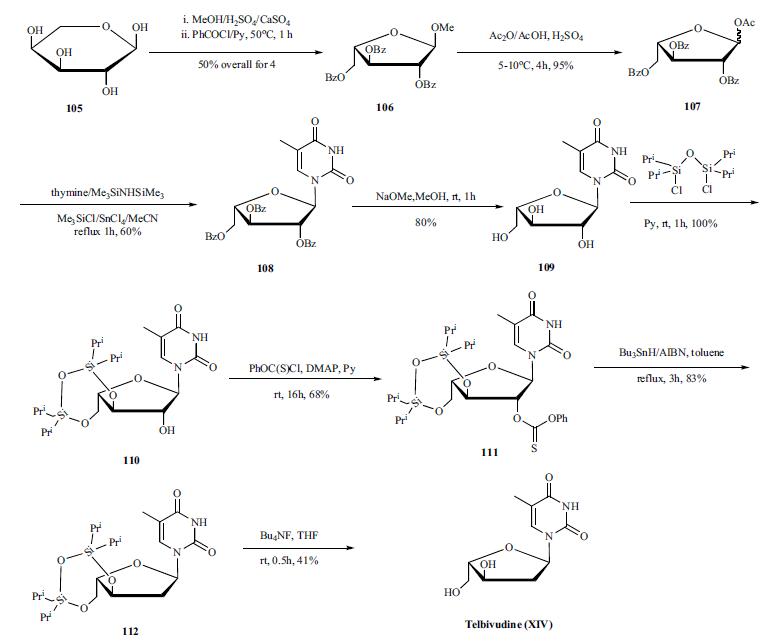Chemical Properties
| Melting point | 185-186?C |
| storage temp. | -20°C Freezer |
| solubility | DMSO (Slightly), Water (Slightly) |
| form | Solid |
| color | White to Off-White |
| FDA UNII | 2OC4HKD3SF |
| NCI Drug Dictionary | telbivudine |
| ATC code | J05AF11 |
Telbivudine Price
| Product number | Packaging | Price | Product description | Buy |
|---|---|---|---|---|
| Usbiological 021325 | 10mg | $425 | Telbivudine |
Buy |
Telbivudine Chemical Properties,Usage,Production
Description
There are approximately 400 million people worldwide with chronic hepatitis B virus (HBV) infection, about onethird of whom have potentially progressive and life-threatening liver disease associated with the infection. Chronic hepatitis B infection can lead to cirrhosis, liver failure and hepatocellular carcinoma. Globally, HBV infection accounts for over one million deaths annually. At present, lamivudine and adefovir dipivoxil are the only approved nucleoside/ nucleotide analogs for the treatment of HBV infection. However, resistance to lamivudine is now recognized in 16 to 32% of HBV-infected patients after the first year of monotherapy and about 50% of patients after two years. With adefovir treatment, the resistance rate is much lower, at about 2.5% after two years of therapy. Experience in treating chronic HIV infections has proven the advantage of therapy with a combination of antiviral compounds. Similarly for HBV, there is a clear need for additional antiviral compounds. Several promising candidates are currently in clinical development. Idenix (then known as Novirio) discovered that the known beta-L-nucleosides, L-dA, L-dC (torcitabine) and L-dT (telbivudine), have highly specific activity against HBV. These L-nucleosides are essentially without activity against any of the other viruses tested and are similarly without effect in cell culture and in vivo toxicological tests. However, they are phosphorylated within human cells to their triphosphates which inhibit the HBV DNA polymerase,but not human polymerases. Of these three compounds, telbivudine was the only one to combine reasonable oral bioavailability with good anti-HBV activity and so was progressed to development jointly with Novartis with the highest priority.Uses
Antiviral (treatment of hepatitis B infection).brand name
(Novirio).Acquired resistance
After 1 year resistance occurred in 7–20% of patients on telbivudine depending upon past exposure to other drugs used in the treatment of hepatitis B and the type of infection. Development of resistance was less frequent in those receiving telbivudine than in those receiving lamivudine.Pharmaceutical Applications
A synthetic thymidine nucleoside analog formulated for oral use in the treatment of chronic hepatitis B infection.Pharmacokinetics
Oral absorption: 100%Cmax 600 mg/kg oral: 3.7 μg/mL
Volume of distribution: In excess of body water
Plasma protein binding:3.3%
It is eliminated renally, necessitating dose adjustment in patients with renal insufficiency. It should not be administered with pegylated interferon because of an increased risk of neuropathy.
Clinical Use
Treatment of chronic hepatitis B in patients >16 years of ageSide effects
Adverse effects are similar to those of lamivudine and include upper respiratory tract infection, headache, fatigue and gastrointestinal upset. Myopathy and peripheral neuropathy are rare but have been observed in some patients several weeks into the course with associated rise in serum creatine kinase levels. Acute exacerbations of hepatitis have been observed on discontinuation of therapy. Lactic acidosis may occur, necessitating drug discontinuation.Synthesis
The synthesis of telbivudeine is depicted in the scheme. The L-arabinose (105) was treated with acid in methanol to form the semi-acetyl intermediate which was then reacted with benzoyl chloride to provide 106 in 50% yield. Acetolysis of 106 with a mixture of acetic acid and acetic anhydride afforded 107 in 95% yield. The α/β mixture was directly condensed with activated thymine to give 108. The nucleoside 108 was purified by column chromatography and characterized as the α-anomer. Debenzoylation of 108 with sodium methoxide in methanol afforded 109. Differentiation of the 2’-OH was achieved by selective protection of the two other hydroxyl groups with 1,3- dichloro-1,1,3,3,-tetraisopropyldisiloxane to form 110. In order to limit undesired reaction during the deoxygenation step, 110 was transformed into o-phenylthiocarbonate 111 which upon treatment with tributyltin hydride under Barton’s conditions afforded 112 in good yield. Desilylation of 112 gave Telbivudine (XIV).
Drug interactions
Potentially hazardous interactions with other drugsInterferons: increased risk of peripheral neuropathy.
Metabolism
Telbivudine is not metabolised. It is eliminated primarily by urinary excretion of unchanged substance.Preparation Products And Raw materials
Telbivudine Supplier
Global(15)Suppliers
| Supplier | Tel | Country | ProdList | Advantage | |
|---|---|---|---|---|---|
| -- | info@neobioscience.com | CHINA | 6681 | 58 | |
| -- | chenjw@absin.cn | CHINA | 6705 | 58 | |
| -- | standards@synzeal.com | India | 6514 | 58 | |
| -- | chemicals@usbio.net | United States | 6214 | 80 | |
| -- | 2248475041@qq.com | CHINA | 2650 | 58 | |
| -- | 15810802415@139.com | CHINA | 6750 | 58 | |
| -- | sales@wheybio.com | CHINA | 4398 | 58 | |
| -- | 344843571@qq.com | CHINA | 6318 | 58 | |
| -- | 847627550@qq.com | CHINA | 6087 | 58 | |
| -- | market@xlswkj.com | CHINA | 6793 | 58 |
Related articles
Uses and side effects of Telbivudine
Telbivudine (b-L-2u-deoxythymidine) is the unmodified b-L-enantiomer of the natural nucleoside D-thymidine. This nucleoside analog is a potent inhibitor of the replication of hepadnaviruses, including human hepatitis B virus (HBV) and woodc
Apr 6,2022
PROMPT×
PROMPT
The What'sApp is temporarily not supported in mainland China
The What'sApp is temporarily not supported in mainland China
Cancel
Determine